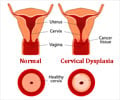Significant racial differences in the risk of dying from cervical cancer have been revealed by a new study.

‘Black women in the United States are dying from cervical cancer at a rate 77% higher than previously thought, while white women are dying at a rate 47% higher.’





Published early online in CANCER, a peer-reviewed
journal of the American Cancer Society, the study also revealed
significant racial differences in the risk of dying from cervical
cancer.To re-examine cervical cancer mortality rates from 2002 to 2012 in the United States, Anne Rositch of the Johns Hopkins Bloomberg School of Public Health, and her colleagues obtained estimates from the National Center for Health Statistics and the NCI Surveillance, Epidemiology, and End Results Mortality Database.
Information on hysterectomy prevalence was gathered from the Behavioral Risk Factor Surveillance System survey to remove the large fraction of women who were not at risk of dying from cervical cancer.
The researchers found that black women in the United States are dying from cervical cancer at a rate 77% higher than previously thought, while white women are dying at a rate 47% higher. Specifically, the corrected mortality rate in black women was 10.1 per 100,000 women, compared with 5.7 per 100,000 uncorrected. The corrected rate in white women was 4.7 per 100,000 compared with 3.2 per 100,000 uncorrected.
Also, without the correction, the disparity in mortality between races was underestimated by 44%. In addition, an analysis of the corrected rates over the decade revealed that white women's rates of death from cervical cancer decreased by 0.8% per year, compared with an annual decrease of 3.6% in black women.
Advertisement
An accompanying editorial by Heather Dalton of Arizona Oncology, and John Farley of St. Joseph's Hospital and Medical Center, highlights the effort that is needed going forward. "Racial disparities in cancer mortality in general and cervical cancer specifically continue to be a vexing problem in the United States," they write. "Access to adequate cervical cancer screening and preventative care remains critical to eliminating racial disparity."
Advertisement















